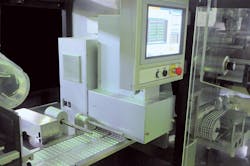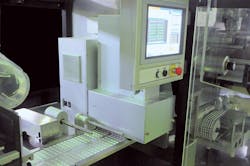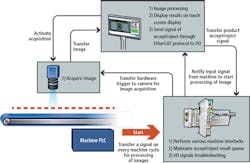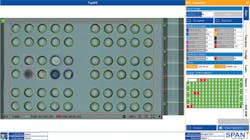Packaging and production: Vision system simplifies blister pack inspection
Used for small tablets/capsules or other consumer goods, blister packs are a type of pre-formed plastic packaging that have two primary components: a cavity made from either some form of plastic or aluminum, and the lidding made from paper, plastic, aluminum or a lamination of soft foil and other substances. The cavity contains the product and the lidding seals the product in the package.
During filling, products are first fed properly to the preformed cavities, then lidding material gets sealed onto the support material. Even though every item may be identified and inspected prior to packaging, the risk of product damage or a mishap during the blister filling process remains.
Needless to say, when it comes to product safety, package integrity and compliance, pharmaceutical companies can ill-afford to take such risks. After all, incorrectly packaged or damaged products may result in expensive manufacturer recalls, potentially fatal accidents and damage to brand reputation.
That's why blister packaging needs to be carefully inspected after primary package filling and prior to secondary packaging. It's not enough to just detect the presence of a product and identify any empty blister cavities. Rather, today's systems must be capable of detecting various defects such as broken product, color variations, shape and size variations, color spots on product, and foreign products contained in the blisters.
The challenge is that the increasing demand for continuous product and package innovation, especially in the pharmaceutical industry, drives constant improvements that hinder the success of traditional automated visual techniques. Not only must automated blister inspection systems be versatile enough to adapt to various blister packaging materials and equipment, but they must also be easy for packaging equipment operators and the people tending the machinery to alter recipes for inspection of various products ranging from tablets and capsules to dragées, ampoules, and applicators.
To resolve these issues, engineers, vision system designers and imaging experts at SPAN Inspection System Pvt. Ltd (Ahmedabad, Gujarat, India;www.spansystems.in) have developed a machine vision-based blister pack inspection system that is dubbed Blisbeat. The system reportedly eliminates user dependency with automated teach technology that the company claims simplifies the set up and configuration process required for product changeovers (Figure 3).
"Traditional systems available in the market today have a very complex teaching process that is extremely difficult for operators to use. The result is an increase in time required to make recipe changes for new products in day to day use," explains Pranay Soni, R&D Lead, SPAN Inspection System Pvt. Ltd. "Our software makes it extremely easy for operators to teach new products. It typically takes less than a minute, even though inspection consistency must be maintained."
The system uses either a Baumer (Radeberg, Germany;www.baumer.com ) VLG-23C or a Basler (Ahrensburg, Germany; www.baslerweb.com ) aca1920-50gc color camera for image acquisition (Figure 4). An M111FM16 16mm focal length lens from Tamron (Commack, NY, USA; http://tamron-usa.com) provides extremely sharp images and minimal optical distortion, according to Soni, that enables Blisbeat to consistently detect the smallest defects.
Images with a 350 x 200mm FOV, containing up to 18 blisters are processed in parallel achieving rates of up to 800 blisters per minute. Soni notes that images are first thresholded in HSV color space, followed by basic blob analysis tools for calculating area, length, width, and convexity. Other advance algorithms for shape and symmetry are applied thereafter followed by color checking of product and foreign product detection algorithms.
Most common pharmaceutical products can be taught automatically, according to Soni. Users simply select a few inputs such as the product type, the number of blisters, and the type of base foil etc., and then press a single button to activate the software, which automatically finds and properly segments all of the product colors and cavities within area of inspection (Figure 5). "Even if a user has to manually teach a new product," Soni says, "it's really simple, because segmentation of the product color is done by using machine learning based on intelligent classifiers."
Blisbeat is equipped with multi-touch core i7 IPC which is full IP65 from Beckhoff Automation (Verl, Germany;www.beckhoff.com) and real-time Beckhoff EtherCAT based I/O module for connectivity and communication with the machine PLC. "After the first two Blisbeat installations now, our customers are very satisfied with the software simplicity, consistent performance and robust hardware," says Soni. "It's also easy to integrate because Blisbeat includes a troubleshooting feature called Live-Scopeview that enables users to view input/output signals online to help identify communication errors with the machine controller or PLC."



